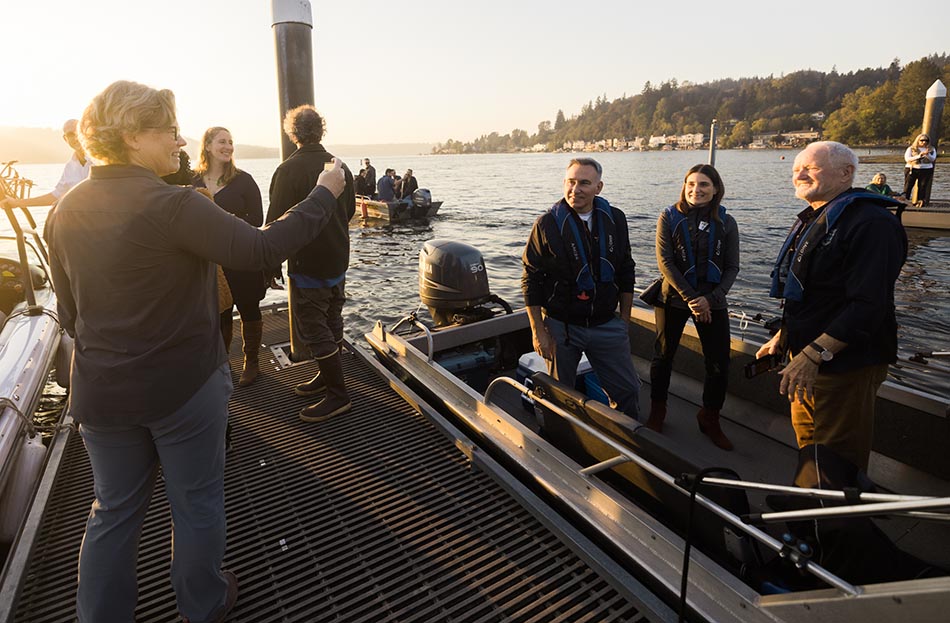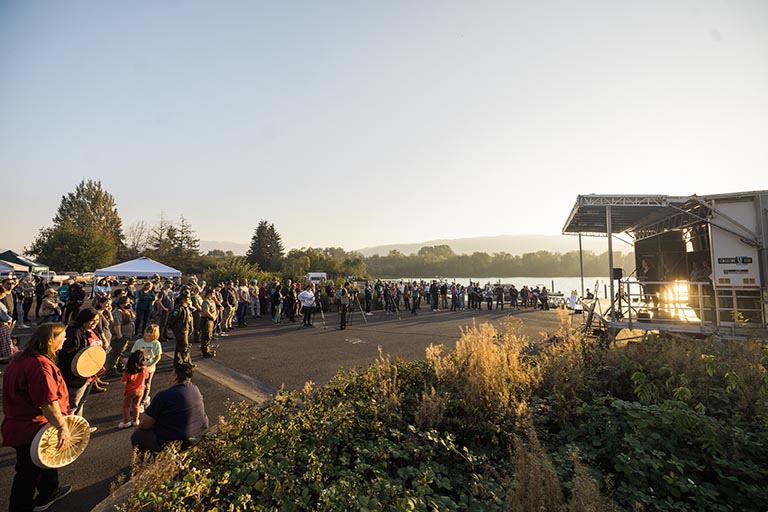Amid promising signs of health for native kokanee salmon, recovery partners release young fish into Lake Sammamish that were flown in from an Orcas Island hatchery
Summary
Following a lakeside celebration that included the Snoqualmie Tribe, partners released young kokanee salmon into Lake Sammamish that had been flown in earlier this year from an Orcas Island hatchery. The group will have released a total of 14,200 into the lake by the end of the year.
Story
Six months after biologists reported the strongest returns of native kokanee salmon in several years, a partnership coordinated by King County on Wednesday released more young fish into the middle of Lake Sammamish. The newly released native salmon were among those transferred on small airplanes earlier this year from a hatchery on Orcas Island.


The Lake Sammamish Kokanee Work Group hosted a lakeside celebration before boats departed to release the fish at sunset in deep water, making it easier for the young salmon to hide from predators as they can acclimate to their new surroundings.
Biologists last year observed more than 2,000 adult kokanee returning to the lake to spawn in tributary creeks, more than the total number of spawners they observed over the previous five seasons combined. The promising signs of health in the population came four years after Executive Dow Constantine announced that the King County Department of Natural Resources and Parks would enact recommendations developed by the work group.
“Ensuring the survival of native salmon requires persistence and ingenuity, and our staff and partners have demonstrated both,” said Executive Constantine. “We’re seeing hopeful signs for the future of ‘the little red fish’ that has been part of Tribal lifeways since time immemorial, and this is a moment to celebrate that progress."
The partners will have released about 14,200 kokanee in Lake Sammamish by the end of the year, including nearly 8,000 in October. Some of the kokanee are the offspring of adult kokanee collected during the recent spawning season and held for an extended period at the state hatchery in Issaquah. Doing so increases the kokanee’s odds of survival by allowing more time for the lake’s temperature to cool and oxygen level to rise.
Earlier this year, small airplanes carried nearly 12,000 offspring of Lake Sammamish kokanee from an Orcas Island hatchery where they were protected from potentially hazardous summer conditions. Warmer water and low dissolved oxygen levels tend to force the fish into narrow bands of cooler, oxygen-rich water, making them more susceptible to the lethal effects of predators and disease.
Biologists believe the new, wider culverts installed along Zaccuse Creek that allow for fish to easily pass under roads and trails contributed to the strong returns by making it possible for more adult kokanee to return to their native streams to spawn. They expect that culvert replacement projects planned for nearby George Davis and Lewis creeks could produce similar results.
In addition to being culturally and historically significant, native Lake Sammamish kokanee are important to the watershed’s biodiversity, with a unique genetic signature that has been shaped by the lake’s diverse characteristics.
The work group – coordinated by King County’s Department of Natural Resources and Parks – includes residents who live in the surrounding watershed, the Snoqualmie Tribe, the cities of Bellevue, Issaquah, Sammamish, and Redmond, the U.S. Fish and Wildlife Service, the Washington Department of Fish and Wildlife, Washington State Parks, Trout Unlimited, Mid-Sound Fisheries Enhancement Group, Mountains to Sound Greenway Trust, Friends of Issaquah Salmon Hatchery, Save Lake Sammamish, Friends of Pine Lake, and Friends of Sammamish State Park.
Relevant links
Quotes
Ensuring the survival of native salmon requires persistence and ingenuity, and our staff and partners have demonstrated both. We’re seeing hopeful signs for the future of ‘the little red fish’ that has been part of Tribal lifeways since time immemorial, and this is a moment to celebrate that progress.
For more information, contact:
Doug Williams, Department of Natural Resources and Parks, 206-477-4543

 Translate
Translate